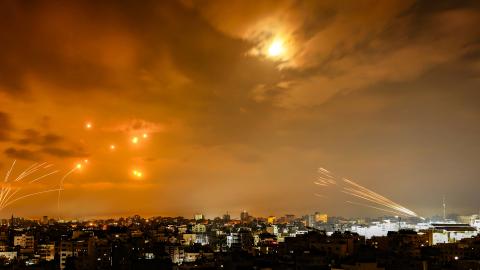Hamas, the designated terrorist group in control of the Gaza Strip, is promising its assault and invasion of Israel will extend all the way to Jerusalem and the West Bank. The entity’s military commander, Mohammed Deif, has urged Arab citizens of Israel to join with Iranian-backed proxies in Lebanon, Iraq and Syria to take up arms against their own homeland. As Deif explains, this is the day of the great revolution –meaning the beginning of the end of Israel.
We don’t yet know whether a coordinated attack against Israel will occur or, if it does, how it will play out.
Regardless, one can make two assessments concerning the Hamas offensive. The first is that the Albanese government’s decision in August to refer to Gaza, the West Bank and East Jerusalem as “occupied” rather than “disputed” territories will now seem naive, ill-thought through and even untenable. The second is that a two-state solution is now even more unlikely than it has ever been.
In designating these regions as occupied Palestinian territory, one might argue the Labor government was merely adopting a terminology endorsed by most members of the United Nations, and, in any event, it changes little in practical terms.
To the extent that it matters, supporters of this position argue that the symbolic shift creates better momentum for the widely endorsed two-state solution. Indeed, this was the justification offered. Symbolism – even if that is all it is – does matter. Otherwise, why do it?
In this context, designating disputed territories as occupied implies the obstacles towards peace and an eventual two-state solution are primarily Israeli in origin and that the latter, in its retreat from so-called occupied lands, will remove the source of the problem.
As the reasoning goes, once we have a safe and secure Palestinian state, then peace is possible in this troubled area of the world. That is the view of the Australian Palestinian Advocacy Network president, Nasser Mashni, and many international commentators who consistently condemn Israeli policy on these issues.
Mashni congratulated the Albanese government for accepting that Israel was illegally occupying Palestinian land and urged Canberra to take the next step in formally recognising a Palestinian state. The dramatic events of the past few days should cause us to reassess this interpretation and narrative.
The notion of an occupied Palestinian state implies there is a coherent and agreed Palestinian entity that can be the basis of a viable state – at least in the eyes of Palestinians. Yet when Israel vacated Gaza in 2005, Hamas fought a brutal war with Fatah, which rules in Palestinian areas of the West Bank.
The political and military violence between these two dominant Palestinian movements continues despite occasional, short-lived peace talks.
In recent years, Fatah has brutally crushed Hamas-backed movements in the West Bank. In the past few days we have seen Hamas-controlled Gaza launch an attack on, and invasion of, the legitimate sovereign state of Israel, with the backing of Iranian proxies.
This has been initiated completely independently of the Fatah-controlled Palestinian entity in the West Bank. One must conclude it is impossible to treat Gaza and the West Bank as a coherent and viable Palestinian political and practical entity. Moreover, Israel evidently does not permanently station troops in, or have dominant control over, the activities in Gaza after its evacuation almost two decades ago.
Meanwhile, there is no international consensus (nor an Australian one) as to what parts of the West Bank ought to belong to a potential Palestinian state.
What specific pieces of land does the current government refer to when it designates all disputed land using the terminology of occupied territories? And in doing so, does it recognise Hamas’s control over Gaza or is Hamas seen as an occupying and illegitimate force, which has been considered a terrorist organisation by Australia since 2001?
What about the prospects for peace given the Hamas invasion?
All reasonable voices accept there is no possibility of peace if one does not accept Israel’s right to exist – even if one might want to alter some existing borders.
This leads to the broader geostrategic rationale behind the Hamas action as it was almost certainly timed to disrupt the promising negotiations between the US and Saudi Arabia, which will lead to Riyadh formally recognising Israel. Islamic states such as Egypt, Jordan, Bahrain, the United Arab Emirates, Sudan and Morocco have already done so.
The Iranian political and military presence and influence are everywhere in Gaza, Lebanon, Syrian and large areas in Iraq. Iran and its proxies openly seek to eliminate Israel from the Middle East, with an essential early step to prevent any further recognition of Israel by other Arab states.
Knowing Israel would retaliate, Hamas calculates the imminent Israeli military counteraction will make it extremely difficult for Saudi Arabia to fast-track these negotiations with the US.
Fatah in the West Bank might see Hamas as the political threat, but it also does not want further normalisation of ties between Israel and Islamic nations as it will become increasingly isolated in refusing to accept meaningful peace talks with Jerusalem.
This is the tragedy. Those ruling the Palestinian territories continue to entrench their power and seek advantage through perpetual disagreement and conflict. Hamas and its backers are showing it exhibits the worst and most dangerous of this trait.















